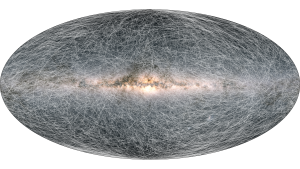Early Gaia Data Release 3 (EDR3)
Released on 3 December 2020
Early Gaia Data Release 3
Released on 3 December 2020.
Gaia Data Release 3 is split into two installments: the early release called Gaia Early Data Release 3 (Gaia EDR3) and the full Gaia Data Release 3 (Gaia DR3), planned for the first half of 2022.
Gaia EDR3 is based on observations collected between 25 July 2014 and 28 May 2017, spanning a period of 34 months.
What does EDR3 include?
- The full astrometric solution (5 parameters) – positions on the sky (α, δ), parallaxes, and proper motions – for around 1.5 billion (1.468 109) sources, with a limiting magnitude of about G ≈ 21 and a bright limit of about G ≈ 3.
- The full astrometric solution has been done as 5-parameter solution for 585 million sources and as 6-parameter solution for 882 million sources. In the 6-parameter solution, the additional fitted quantity is the so-called pseudo-color that had to be included for sources without high-quality color information.
- In addition, two-parameters solutions – positions on the sky (α, δ) – for around 344 million additional sources.
- G magnitudes for around 1.806 billion sources.
- GBP and GRP magnitudes for around 1.542 billion and 1.555 billion sources, respectively.
- Full passband definitions for G, GBP, and GRP.
- About 1.614 million celestial reference frame (Gaia-CRF3) sources.
- Cross-matches between Gaia EDR3 sources on the one hand and Hipparcos-2, Tycho-2 + TDSC merged, 2MASS PSC (merged with 2MASX), SDSS DR13, Pan-STARRS1 DR1, SkyMapper DR2, GSC 2.3, APASS DR9, RAVE DR5, allWISE, and URAT-1 data on the other hand.
- A Gaia DR2 to Gaia EDR3 match table.
- Simulated data from Gaia Object Generator (GOG) and Gaia Universe Model Snapshot (GUMS).
- The commanded scan law covering the Gaia EDR3 data collection period. Also, the major periods where data was not sent to the ground or could not be processed are identified.
- To ease the use of the data, the Gaia EDR3 source table in the Gaia Archive is complemented with a set of (cleaned) Gaia DR2 radial velocities.
How to access data?
The Gaia Archive is the main point of access for the Gaia Early EDR3 data, from where data can be extracted by performing a basic search using a web form, or by performing ADQL queries and subsequently downloading the corresponding results tables. Programmatic access of the Gaia Archive is available as well.
The Gaia EDR3 data set is also downloadable in compressed CSV format (~1.3 TB). The increased size, compared to Gaia DR2, is mostly due to the addition of extra information from the Gaia Object Generator (GOG) and Gaia Universe Model Snapshot (GUMS), and due to the increase in the number of sources in the catalogue. The cross-matches with external catalogues are also available for bulk download.
The bulk download can be found from the homepage of the Gaia Archive.
Following the journey of stars across the sky
A major improvement in Gaia Early Data Release 3 (Gaia EDR3) with respect to Gaia DR2 is the precision to which the motions of stars across the sky, the so-called proper motions, have been measured. The precision has increased by a factor of 2 because of the larger number of observations processed for Gaia EDR3 and the larger time difference between the first and last observation.

More information
Watch the following animation to better understand the image:
Visit ESA’s cosmos website for more details on this EDR3!
IMAGE OF THE WEEK